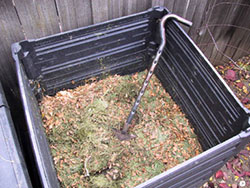Soil isn’t just something that gets on your shoes, it’s the foundation of any good garden and landscape. Top soil, the rich, upper layer of earth, is usually lost during home construction. The soil left is mostly heavy clay, very light sand, or, in the foothills and mountains, shallow and rocky.

Clay soils absorb water very slowly while sandy or rocky soils lose it too quickly. Working organic matter into these soils can make them more productive. This is called amending the soil. Organic amendments open air space in clay and add water holding ability to sandy and rocky soils, improving water retention and drainage. Organic materials include compost, peat moss and aged manure.
Add 3 cubic yards of organic matter per 1,000 feet to spread one to three inches of organic material onto the surface of the soil. Work the material into the top layer of soil to a depth of six to eight inches. This will help a garden flourish while using less water.
Avoid using mountain peat as an organic material. The mining of Colorado peats destroys mountain meadows, and it’s not a good soil amendment. Peat from Canada, Minnesota and Michigan come from much different environments. And, it is acidic and fibrous, making it a good soil amendment.
Whether using a manure, compost or peat, amending the soil will make it more productive. Plants will grow better and need less water, which is the goal of xeriscape.
For more information, see the following Colorado State University Extension fact sheet(s).
- Xeriscaping: Creative Landscaping
- Vegetable garden: Soil Management and Fertilization
- Choosing a Soil Amendment



